By Jeffrey A. Rendall, Photos By Jeffrey A. Rendall
CHAMPION, PA – There are times when you’ll read about a golf destination, start formulating a set of assumptions, then when you get there, it turns out completely differently.
That’s the situation at Seven Springs Mountain Resort in Pennsylvania’s Laurel Highlands – an outdoor recreational playground a little over an hour from Pittsburgh in the southwestern part of the state.
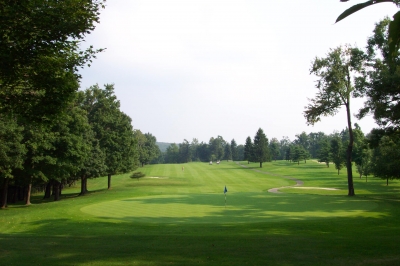 |
| Looking back from Seven Springs' 17th hole -- great beauty, great conditions and nice views. |
In Seven Springs’ case, the faulty assumptions involve mountain golf. Since its golf course is on top of a mountain, you’re probably thinking you’ll experience some dramatic drops, some crazy holes cut into slopes (or filled to create a surface) and cart paths that require seatbelts and steady nerves to endure.
Nothing’s further than the truth where Seven Springs is concerned. There’s a certain charm accompanying golf in the mountains, and the layout at Seven Springs seems to bring that out, while leaving some of the less desirable aforementioned-attributes to somewhere else.
Matt Trimbur, Seven Springs’ Head Golf Professional, puts it succinctly: “If someone asked me to describe our golf course, I’d say it’s a mountain-top layout that doesn’t play like one. Sure, we have some elevation variation on the property – and you’ll see it when you’re out there. But at the same time, most of the holes really aren’t dictated by the difference in elevation from tee to green, like most mountain courses are.”
He continues, “I think the biggest drop on the course is on a par three, our signature eleventh hole, so the changes are really subtle. It’s not like you’ll go straight up and straight down – it plays a lot like some of the low-land courses in western Pennsylvania.”
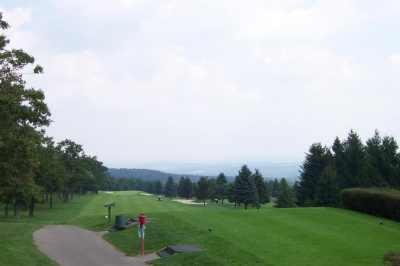 |
| It was a bit hazy the day we were there, but on a clear day, you can see for miles from Seven Springs' first tee. |
“Plus it offers such grand vistas,” Trimbur added.
Don’t forget those vistas. Stand on the first tee and you’ll take in the view of the Pennsylvania plains below you. You’re in the mountains, with all that entails, but you’re also playing a very gentle golf course, friendly to local resident members and resort guests alike.
According to Trimbur, Seven Springs ski resort opened in 1932, owned and built by the Dupre family. Founder Adolph Dupre emigrated from Bavaria, a landscaper and horticulturalist by profession. He discovered this land up on the mountain, and found it to be very similar to that in his homeland. Dupre fell in love with the area, and when he was surveying the property found seven springs that were used to draw water to feed the farms on the land – hence the name, Seven Springs.
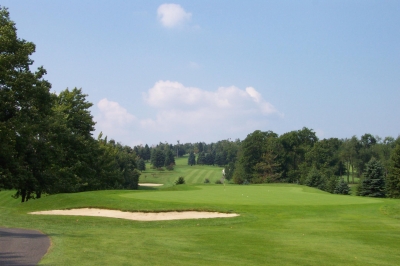 |
| Here's the approach to the short par four 13th hole -- At 313 yards and a slight dogleg right, some might think they can get close off the tee. The better play is to lay up and take a wedge into the green. |
The resort is still owned and operated by the Dupre family. The golf course is only a fraction of what you’ll find there, but an important part, nonetheless.
The layout was built in the late sixties, designed by Xen Hassenplug (that’s quite a name!). Hassenplug worked with Philip Dupre (one of the owners at the time) on the initial layout, opening the first nine (now the back nine) in 1969, with the final nine coming on board a year later.
In subsequent decades, architects Fred Garbin and Ron Forse came in to make some changes, bringing the course to where it is today. It’s got a few narrow holes lined by mature trees, but in general it’s much more open than most mountain courses. In the tradition of resort golf, it’s pretty friendly off the tee, and not overly long at just under 6,500 yards from the back tees (6,454 yards, par 71, slope 131).
Trimbur says the course isn’t so tame when you get closer to the flag: “We do have a couple blind tee shots, but in general the layout is pretty wide-open. You’re probably not going to lose a lot of golf balls off the tee here, but you’ll definitely be challenged by your approach shots. The par fours play a lot longer than the listed yardage, and if you miss a green, you’ll be penalized. Most all of our greens are elevated or mounded, so if you’re in the rough you’ll have to flop it up there.”
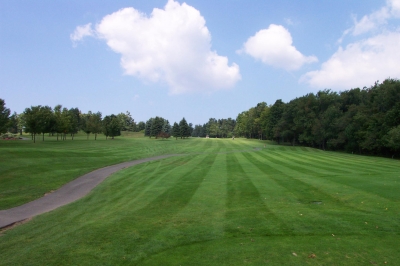 |
| The 531-yard, par five 5th hole used to be called 'Big Bend.' There's a severe dogleg left, so you'll see why when you play it. |
Two of Seven Springs’ three par fives are reachable in two, and the third, at 531 yards (uphill) will also offer a scoring chance for three well-placed shots. In that same theme, the par threes are reasonably short, the longest being the eleventh at 209 yards and downhill. The 104-yard (from the back tees) par three third hole is one of the shortest one-shotters you’ll ever see on a regulation-length championship golf course, yet it’s well bunkered with a steeply sloping green that’ll still require a pretty solid tee shot.
As alluded to in the last sentence, the greens themselves will cause you fits on Seven Springs’ layout. They’re not really domed, but the slopes and creative pin placements will present a formidable challenge.
The 337 yard, par four second hole offers a good example. My second shot was on the fringe to the right of the flag – which provided a straight downhill putt to the hole. Tapping it a bit, the ball rolled twenty feet by. “We see a lot of five-putts on that green,” Trimbur said, and it’s easy to see why.
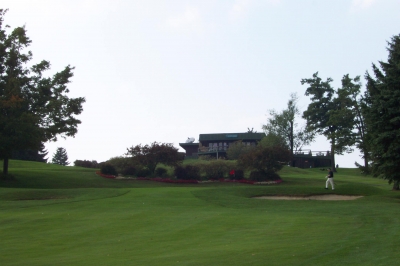 |
| Heading in on the par four 18th hole. The clubhouse may be on top of the hill, but the entire course plays only gently up and down. |
The tricky second green and the fact that the first hole faces dead-east into the sun can make for a slow start in the morning at Seven Springs, though Trimbur says they’re pretty vigilant about maintaining pace-of-play – and from what we saw, he’s true to his word. The course is well marshaled, and once you get past the opening hurdles, it moved along very well.
And while the course is definitely playable, it won’t surrender many low scores. Again, Trimbur expounds: “We have an annual event up here, the Seven Springs Open, where all the tri-state section PGA professionals come up and participate. It’s a one-day, 18-hole event, and I believe the lowest score ever in winning the event was a 67 – and that’s only four-under par. The course won’t beat you up, but it also won’t give up a lot of birdies.”
There’s another area where you’ll think you’re playing a professional tournament worthy club, namely the course conditions. We toured Nemacolin Woodlands’ Mystic Rock (Home of the PGA Tour’s 84 Lumber Classic) the day before heading to Seven Springs, and the latter was certainly in comparable shape to the former (a PGA Tournament venue). The fairways were in excellent condition, the rough was thick and the greens were slick yet puttable (even with the slopes).
“We’re very proud of the condition of the course, and that’s really what keeps people coming back,” Trimbur said. “The golf course was recently rated highest in the entire resort for overall customer experience, and that’s because of the way we maintain the conditions. For a resort course, players can’t believe the speed of the greens, the condition of the fairways. People are coming from some private clubs in and around Pittsburgh, and they’re saying our course is in far superior condition to their own course.”
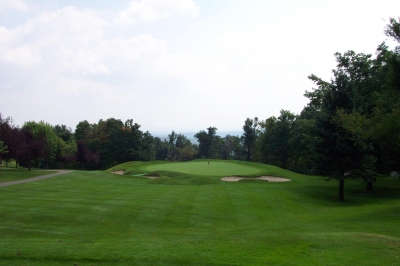 |
| Even at 104 yards, the par three third hole is no automatic birdie or par. |
Not having witnessed any of the private clubs in the Pittsburgh area, I can’t say – but I will add that the Seven Springs’ course was in darn good shape for the fee they charge. There was well-done landscaping as well, though it’s somewhat sporadically placed. The course would raise itself yet another notch in quality with more of the colorful flora planted throughout the entire 18 holes.
A final notable point on Seven Springs’ layout is its closing two holes. Trimbur says they’re the toughest finishing links in the area, and he’s got a good case. The 17th measures 434 yards and plays uphill the whole way. The green is set back in a little cove of trees, which presents a very attractive picture. The second shot’s uphill, and you’re looking through the trees into the 18th fairway ahead. It’s a very demanding, memorable hole.
Similarly, the 18th hole plays quite a bit uphill, with the clubhouse as the backdrop to the green. Not nearly as lengthy at 388 yards, it’ll play probably 40-50 yards longer than the scorecard listing because of the slope. Like most of the holes at Seven Springs, there’s quite a lot of room to drive the ball, but your second shot better clear the big bunker that guards the putting surface in order to have a good shot at a final par.
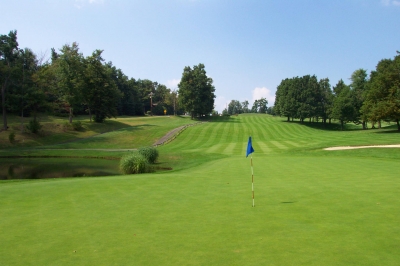 |
| Seven Springs' signature hole, the par three 11th. To the left in the picture is a large pond -- which makes it slicer's paradise off the tee. |
In addition to the golf at Seven Springs, you’ll find something you might not initially expect – great attitudes. “I want our players to leave with the thought that they were treated with superior customer service, and I want the overall experience to be unforgettable with respect to the playability of the golf course, the beauty of the resort and the attitude of the staff,” Trimbur added.
“I want everything to be perfect… I’m still working on my staff,” Trimbur chuckled.
Trimbur needn’t be so humble – he and the staff made the day very enjoyable. A mountain-golf experience with a flatlands feel… something you might not expect from just reading it in black and white.
Where We Stayed
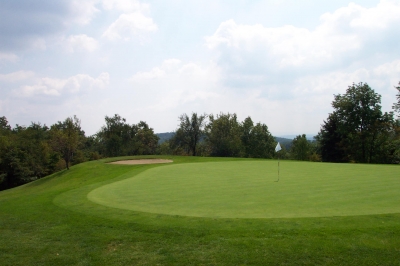 |
| Greenside at the par four 4th hole. |
On our visit to the Laurel Highlands, we stayed at Nemacolin Woodlands Resort – about a forty-five minute drive from Seven Springs, and a very scenic journey at that. You can read the full story of Nemacolin Resort and its PGA Tour Venue Mystic Rock golf course by clicking here.
Otherwise, here are some general impressions of Nemacolin and suggestions on what to do when you’re there:
Accommodations – as a resort of this type should, Nemacolin offers several different types of overnight sleeping quarters, from single hotel rooms and suites to condos and townhouses – ranging from comfortable to ultra-luxurious. We stayed at The Lodge, which worked well for families with young children (but could just as easily accommodate couples looking for a little space and privacy). Our one-bedroom suite contained a king-sized bed, two TV’s, a balcony and a good-sized bathroom with Jacuzzi tub. It’s all the comforts of home, but a lot more fun in the setting.
 |
| The 17th hole's green is tucked nicely in a grove of trees, and you can see straight through to the 18th fairway. |
What to do – Every resort offers you the option to do nothing, essentially relaxing in beautiful surroundings where the most work you’ll have to do is raise your hand to attract the waiters’ attention. You can do that at Nemacolin, too, but if you fail to take advantage of some of the resort’s special activities, you’re missing out.
--The Spa. Though we didn’t get a chance to visit, it certainly looks like it’s equipped with all the treatments and facilities that you’ll ever desire.
--Outdoors. Here’s where Nemacolin excels, with perhaps a little ‘western attitude.’ Of course there are the usual hiking options, tennis and swimming. But you’ve also got an equestrian center, fly fishing, a shooting academy and most unique of all, the Hummer Driving Academy – where you’ll not only learn how to pilot one of those off-road monsters, they’ll send you off onto a course where you’ll get to see what it can do. Again, we didn’t get a chance to do it, but it looks like fun!
You certainly won’t feel compelled to go off property to find more recreational choices, but several more are nearby, including Frank Lloyd Wright’s masterpiece, Fallingwater, as well as whitewater rafting and a little bit of history at Fort Necessity National Battlefield.
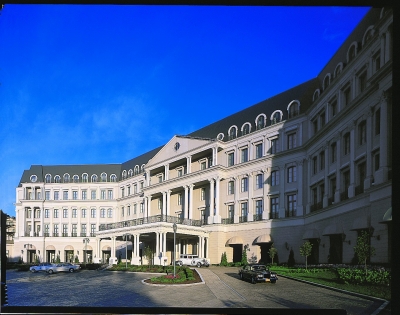 |
| Fine luxury awaits at Nemacolin Woodlands Resort. |
Note: Check links below for other regional reviews.
Details:
Seven
Champion, PA
Phone: 800-452-2223
Website: www.7springs.com
Course Designer: Xen Hassenplug
Head Golf Professional: Matt Trimbur
Tees/Yardage/Slope/Rating
Blue 6454 131/71.7
White 6159 129/70.6
Red 4934 119/68.9
2005 Rates:
18 Holes with a cart, M-F: House Guest: $58, non-House Guest: $68. Weekends & Holidays, House Guest: $67, non-House Guest: $72.
9-hole and twilight rates also available, check the website.
Walking is permitted most afternoons.
| Related Links | Comments on this article? | |
|
Maryland National Golf Club Hollow Creek Golf Club Rocky Gap Resort PB Dye Golf Club in Ijamsville Whiskey Creek Golf Club |
E-mail Jeff Rendall, Editor: jrendall@golftheunitedstates.com |











